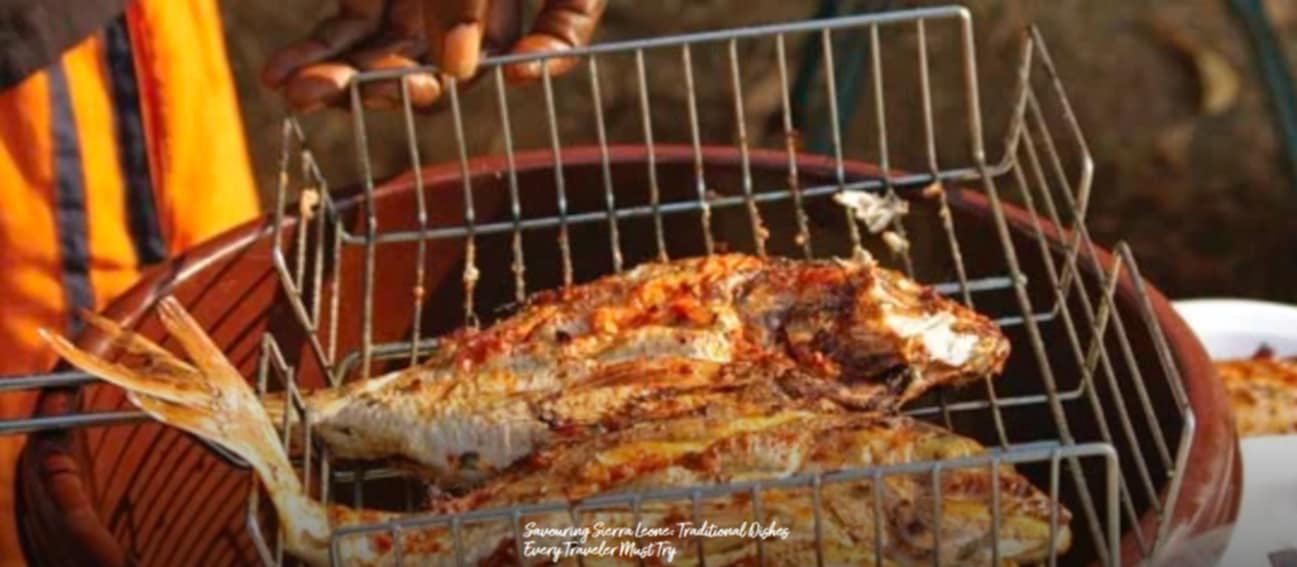When people think of West African cuisine, countries like Nigeria or Ghana might come to mind first. But nestled along the Atlantic coast, Sierra Leone offers an equally rich and delicious food culture that remains one of Africa’s best-kept secrets. With its lush tropical laandscape and diverse heritage, Sierra Leone’s traditional dishes are full of flavour, history, and heart.
From steamy bowls of spicy soup to comforting, home-cooked meals shared among families, the country’s cuisine reflects both its resilience and hospitality. Whether you’re sampling street food in the heart of Freetown or enjoying a home-cooked dish in a remote village, Sierra Leonean food is a deeply sensory experience you won’t forget.
Here’s a journey through some of the most iconic and beloved dishes that define the Sierra Leonean table.
Cassava Leaves – The Heartbeat of the Kitchen
If Sierra Leone had a culinary ambassador, it would be Cassava Leaves. This dish is more than just a favourite—it’s a national treasure. Prepared by finely chopping fresh cassava leaves and simmering them in palm oil with groundnuts, seasonings, and either fish or meat, the dish bursts with earthy richness. It’s always served with rice, which forms the backbone of most Sierra Leonean meals.
Cassava Leaves is often the centrepiece of Sunday meals or celebrations, offering a comforting, homemade taste that links generations through shared recipes and memories.
Groundnut Soup – A Creamy Comfort
Another standout in Sierra Leone’s food repertoire is Groundnut Soup, a luscious, nutty stew made from ground peanuts, tomatoes, onions, and spices. Chicken, beef, or fish adds protein, while the soup’s velvety texture and warming heat make it ideal for a satisfying lunch or dinner.
Often accompanied by fufu—a starchy dough made from fermented cassava—or plain white rice, Groundnut Soup is both nourishing and deeply rooted in tradition. It also showcases the country’s use of local ingredients to craft dishes that are as wholesome as they are delicious.
Jollof Rice – A Pan-West African Favourite
Jollof Rice may be the most hotly debated dish in West Africa, with each country claiming superiority. Sierra Leone’s take on Jollof is rich, colourful, and full of life. It’s made with rice cooked in a vibrant tomato sauce seasoned with onions, garlic, thyme, and chilli peppers, often accompanied by chicken or fish.
Popular at weddings, parties, and festivals, Jollof Rice is more than a dish—it’s a celebration on a plate. Served with fried plantains and a side salad, it’s a complete and festive meal that unites people across regions and backgrounds.
Fry Fry – Sierra Leone’s Street Food Staple
If you’re exploring the markets of Freetown or strolling along a dusty village road, you’re bound to encounter Fry Fry—a term that refers to a range of fried snacks popular throughout the country.
Typical Fry Fry items include akara (bean fritters), puff-puffs (sweet dough balls), fried yam slices, and crispy plantains. Perfect for breakfast or a midday snack, these goodies are best eaten hot and fresh, straight from the sizzling oil of a roadside vendor’s pan.
Plasas – A Green Revolution
In Sierra Leonean homes, leafy greens are elevated into something special. Plasas refers to a variety of stews made from green vegetables like potato leaves, spinach, or krain krain (jute leaves). These greens are cooked with palm oil, onions, groundnuts, and fish or meat.
Nutritious and packed with flavour, Plasas is a testament to the country’s resourcefulness, using what grows abundantly to create dishes that feed both body and soul.
Fufu – The Classic Companion
You haven’t truly dined in Sierra Leone until you’ve eaten with your hands, and fufu is the reason why. This soft, elastic dough is made by pounding fermented cassava or yams until smooth and stretchy. It’s served alongside hearty soups and stews and used as an edible scoop.
Eating fufu is an experience—tear off a bit with your fingers, shape it into a small ball, dip it into a spicy sauce, and savour the balance of texture and flavour. It’s rustic, traditional, and deeply satisfying.
Pepper Soup – Fire and Healing
Looking for something to clear your sinuses or kick a cold to the curb? Try Pepper Soup. This fiery broth made with local peppers, aromatic spices, and meat or fish is as medicinal as it is mouth-watering.
Served hot, it’s often believed to have healing properties and is a go-to dish for special occasions or when someone needs a little pick-me-up. It’s bold, spicy, and unapologetically flavourful.
Agidi – A Gentle Complement
Also known as corn pudding, Agidi is a soft, jelly-like side made from fermented cornmeal. Its subtle taste makes it the perfect partner to spicy dishes like pepper soup or groundnut stew. It’s light yet filling, offering a mellow contrast to bolder flavours.
Roast Fish – A Coastal Classic
Given its Atlantic coastline, Sierra Leone is rich in seafood. Roast Fish, often grilled over an open flame and marinated with lime, ginger, and herbs, is a beachside staple. Whether served with rice, salad, or fried plantains, it’s a dish that captures the essence of the ocean and local spice traditions.
Coconut Cake – The Sweet Finish
No Sierra Leonean meal is complete without a sweet treat, and Coconut Cake tops the list. This moist dessert made from grated coconut, sugar, and nutmeg is often enjoyed during festivities or family gatherings. Lightly sweet and full of tropical aroma, it’s the perfect end to a flavourful journey.
Conclusion: A Feast of Culture and Community
Sierra Leone’s food is more than a collection of recipes—it’s a living expression of its people, history, and landscape. Every dish carries stories, traditions, and a sense of community that invites you to sit down, share a meal, and connect.
So, the next time you’re planning a culinary adventure, consider Sierra Leone—not just to eat, but to experience a culture where food is a language of love, resilience, and celebration.



































